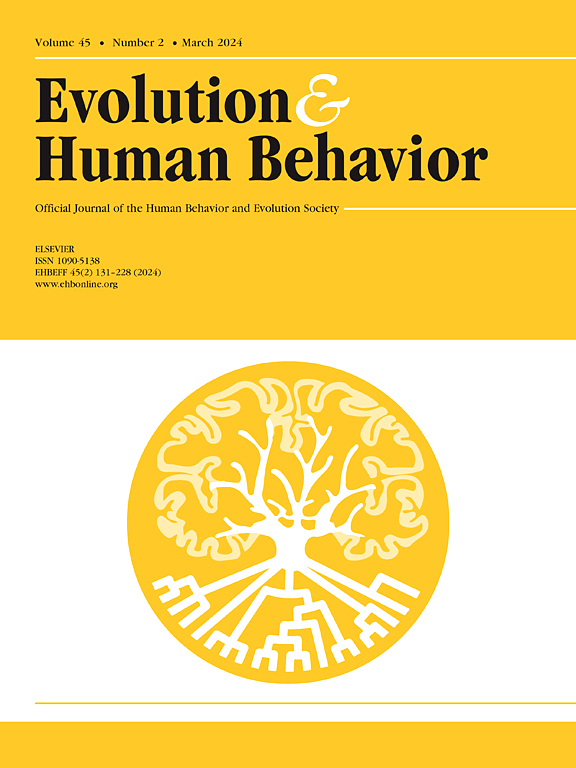Understanding olfactory fertility cues in humans: chemical analysis of women's vulvar odour and perceptual detection of these cues by men
IF 3.2
1区 心理学
Q1 BEHAVIORAL SCIENCES
引用次数: 0
Abstract
By conveying cues of their current fertility, females can provide valuable reproductive information to conspecifics. Our closest relatives, non-human primates, employ diverse strategies, including olfactory cues from the anogenital region, to communicate information about female fertility. While their shared phylogeny with humans suggests that analogous olfactory cues may have been preserved in modern women, empirical evidence is lacking. In a comprehensive two-fold approach, we investigated fertility-related shifts in the chemical composition of women's vulvar volatiles as well as men's ability to perceive them. We collected vulvar odour from 28 naturally cycling women (students, academic staff members, and citizen of Göttingen) on up to ten days of their menstrual cycle, focusing on fertile days. For 146 vulvar samples (subsample of n = 16 women), we assessed whether their volatile profiles varied in relation to female fertility using gas chromatography–mass spectrometry. Simulating a first encounter, 139 men evaluated a total of 274 vulvar odour samples from 28 women, collected on different cycle days. We used hormonal analyses to confirm women's fertile days. We assessed variation in chemical composition and male odour ratings in relation to women's conception probability, temporal distance to ovulation, and ovarian hormone levels. We found no evidence for chemical changes allowing tracking of fertility across the cycle. However, in the immediate assessment (i.e., without tracking), no significant effects were found for any predictors except conception risk. Notably, the significance of the conception risk effect varied depending on the model specification. Further, men's attraction to vulvar odour was not significantly predicted by female fertility. Overall, our data suggests a relatively low retention of chemical fertility cues in vulvar odour of modern women.
了解人类的嗅觉生育线索:女性外阴气味的化学分析和男性对这些线索的感知检测
通过传递其当前生育能力的线索,雌性可以向同种生物提供有价值的生殖信息。我们的近亲,非人类灵长类动物,采用多种策略,包括来自肛门生殖器区域的嗅觉线索,来传达有关女性生育能力的信息。虽然她们与人类共同的系统发育表明,现代女性可能保留了类似的嗅觉线索,但缺乏经验证据。在一个全面的双重方法中,我们调查了与生育有关的女性外阴挥发物化学成分的变化以及男性感知它们的能力。我们收集了28名自然月经周期的女性(学生、学术人员和Göttingen的公民)的外阴气味,这些女性的月经周期最长为10天,重点是生育期。对于146份外阴样本(n = 16名女性的子样本),我们使用气相色谱-质谱法评估了它们的挥发性特征是否与女性生育能力有关。139名男性模拟第一次接触,评估了28名女性在不同月经周期收集的274份外阴气味样本。我们用荷尔蒙分析来确定女性的受孕日期。我们评估了化学成分和男性气味评级的变化与女性受孕概率、排卵时间距离和卵巢激素水平的关系。我们没有发现任何化学变化的证据,可以追踪整个周期的生育能力。然而,在即时评估(即没有跟踪)中,除了受孕风险外,没有发现任何预测因素的显著影响。值得注意的是,概念风险效应的显著性因模型规格而异。此外,男性对外阴气味的吸引力与女性的生育能力没有显著的关系。总的来说,我们的数据表明,现代女性外阴气味中化学生育线索的保留相对较低。
本文章由计算机程序翻译,如有差异,请以英文原文为准。
求助全文
约1分钟内获得全文
求助全文
来源期刊

Evolution and Human Behavior
生物-行为科学
CiteScore
8.30
自引率
9.80%
发文量
62
审稿时长
82 days
期刊介绍:
Evolution and Human Behavior is an interdisciplinary journal, presenting research reports and theory in which evolutionary perspectives are brought to bear on the study of human behavior. It is primarily a scientific journal, but submissions from scholars in the humanities are also encouraged. Papers reporting on theoretical and empirical work on other species will be welcome if their relevance to the human animal is apparent.
 求助内容:
求助内容: 应助结果提醒方式:
应助结果提醒方式:


